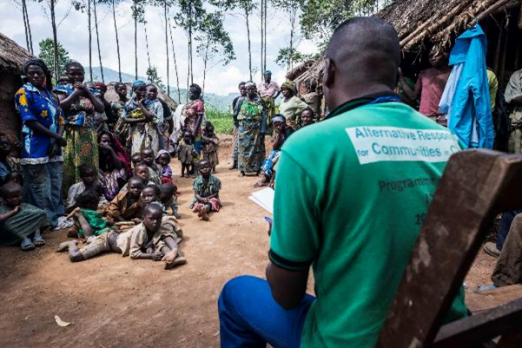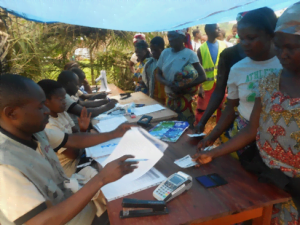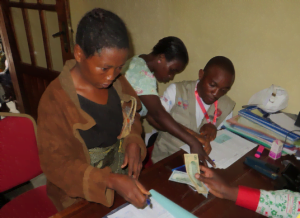UNICEF’s Alternative Responses for Communities in Crisis (ARCC) programme – The largest Humanitarian Multi-Purpose Unconditional Cash Transfer Program in the DRC

Journey from sectoral to multi-purpose assistance
The Democratic Republic of Congo (DRC) is a prime example of a protracted emergency. The first large-scale population movement and humanitarian crisis dates back to the early 1990’s with tens of thousands fleeing inter-communal conflict in North Kivu’s Masisi territory. This was shortly followed in 1994 with the first huge waves of refugees entering the Kivu region in the wake of the Rwandan civil war and genocide. Since then there have been two full-scale civil wars which have caused what is considered the most severe humanitarian crisis since the end of the Cold War[1]. Today 56 recognized active armed groups are roaming eastern DRC causing 2.8 million[2] people to be displaced in an area half the size of Western Europe.

During the last 21 years internal displacement has become a tragic routine. UNICEF and its partners developed different context-specific approaches to best address children and families’ needs while also looking to take advantage of different opportunities and technologies offered by non-traditional humanitarian partners, including the private sector, to improve assistance to conflict-affected populations. After a decade of traditional humanitarian distributions, in 2004 the first seed voucher fairs were organized by food security actors in DRC. In 2008 UNICEF initiated the use of the voucher fair method as an alternative to traditional Non Food Items (NFI) distributions. The ‘NFI Fair’ allowed affected families to choose their own assistance while also helping to revitalize the local economy of affected areas. Today nearly all NFI actors in the DRC are using the NFI fair approach in addition to traditional distributions, and over 65% of all families receiving NFI assistance in the DRC are accessing it through vouchers[3].

While the NFI fairs have been a great success in offering families greater flexibility, they are still limited to a ‘single’ sector. In the interest of pushing toward even greater flexibility, in 2011 UNICEF initiated its first pilots to test multi-purpose unconditional cash approaches. This was the beginning of the Alternative Responses for Communities in Crisis (ARCC) Programme funded by UK aid from the British people, which through the Department for International Development still supports ARCC II today.
Sector specific responses in food, NFI, health, etc. are certainly still relevant even in protracted emergencies like the DRC, but if one considers the huge proportion of the population who have experienced multiple waves of displacement and return, it is important to recognize that their diversity of needs can be better served by cash-based responses which are multi-sectoral or ‘multi-purpose’. Such flexible approaches have proved to respond in a more appropriate way to the heterogeneity of needs of medium to long term returnees, and internally displaced people, as well as their host families. UNICEF and partners are now finishing the second cycle of the two-year (2013-2015) ARCC programme which involved five international implementing partners. One unique feature of ARCC II has been its strong focus on operational research which allowed UNICEF to test the cash approaches in different sectors: Humanitarian/transition; Nutrition; Education; and Protection/GBV. This article will focus only on the humanitarian/transition response component which has the largest coverage in terms of area and beneficiaries.

Implementation meets operational research
UNICEF worked with three international NGO partners – Concern Worldwide, Mercy Corps and Solidarités International – to use different multi-purpose cash-based approaches in eight different territories of North Kivu and Oriental Province. The objective of this program was to provide vulnerable families affected by population movement shocks with access to unconditional cash transfers in order for them to address the multiplicity of their needs: access to essential goods and basic services while reducing negative coping strategies. The needs assessment as well as the targeting was done on a geographic level (villages) as well as at a demographic (household) level. For the geographic targeting, a mix of criteria was used to ensure the targeted locations had acceptable levels of security, did not have other NGOs present, and had been affected in a significant way by a recent or long term displacement. On the other hand the demographic targeting of households was carried out with a community-driven approach whereby village committees helped UNICEF’s partners in identifying the most vulnerable individuals according to a set of criteria defined by the community itself (e.g.; IDPs and Returnees HHs[4], Handicapped, Elderly, Chronic Illness, Single Parent HH, IDPs Host Families, poor food consumption score, poor NFI Score[5], etc.). Finally the list of beneficiaries was made public for everyone to have their say on eventual fraud or families who met criteria who were missing from the lists. During the 17 months of program implementation, 23,534 families (117,670 people) were served with unconditional cash transfers or multi-purpose vouchers (through fairs and in open markets), making ARCC II the biggest program of its kind in DRC.
In addition to providing critically needed assistance to vulnerable conflict-affected families, ARCC II was also developed as an operational research program to explore and gather evidence about the effectiveness and feasibility for scaling up the use of multi-purpose unconditional Cash-Based Response (CBR) in eastern DRC. For this reason the consortium implementing the humanitarian/transition output developed a common monitoring framework across the three partners looking at two key areas:
- Changes in participating families’ ‘well-being’ as defined as increased access to basic needs, services, and livelihood opportunities and reductions in use of negative coping strategies ; and
- Detailed purchasing pattern analysis.
Implementing partners and UNICEF agreed on a set of different qualitative and quantitative data collection tools which have been administered to a representative sample of the beneficiary population stratified according to the different areas of interest of the research. For this purpose an open source mobile data collection solution was used to ensure sound data collection and rapid database consolidation.
ARCC II’s operational research is focused on understanding if there were any meaningful differences in purchasing patterns and in subsequent contributions to reduced vulnerability and increased well-being based on:
- Different delivery plans—families receiving one-off lump sums vs. receiving the same amount in multiple smaller instalments over several months.
- Different delivery mechanisms and modalities – cash vs. vouchers, and for cash – transfers – different modalities including cash in envelopes, via mobile money, local financial institutions.
- Whether the primary beneficiary[6] of the assistance was (as randomly determined by the NGO partner) the wife, the husband, or if the couple was allowed to choose who received the transfers.
It is important to mention that while randomized control trial studies were not possible due to contextual constraints, the rigorous monitoring framework put in place will allow ARCC II to understand the most important operative as well as programmatic implications of multipurpose humanitarian cash interventions in DRC.

Identifying appropriate delivery methods
The total amount transferred to each family was calculated according to a mixed basket of goods and services which varied in the different territories and included essential NFI items, school as well as health care fees, basic food stock and some productive tools. The total amount varied among territories between $110 and $135, with the exception of a pilot project for extremely vulnerable households who received a total of $225 in monthly instalments over an eleven month period in North Kivu’s Masisi Territory.
Each partner did a thorough analysis of the potential delivery methods available in their area. In most cases, there were not multiple options, and the context often dictated the delivery method to be used. Transfer delivery methods used by ARCC II partners ranged from direct cash delivery at the NGO office to local level savings and loan cooperatives and Mobile Network Operators (MNO) doing the deliveries for those areas where cash was the most suitable option. In others areas where it was less evident to deliver cash a mix of fair and open market-approaches through traditional paper voucher or innovative e-voucher solutions were used. This allowed UNICEF to experience the multiplicity of cash & voucher delivery methods available in DRC. Direct cash delivery resulted in the cheapest method with a cost-to-transfer ratio of $ 0.87[7]. This information shows how poor infrastructures and substandard private sector are still a barrier to this kind of responses in DRC. However as the private partners’ offer of payment products is quickly developing, ARCC’s learning is expected to pay off in terms of efficiency in the next cycle of this program, which is likely to be funded with a basket fund through fall 2017.

Focus on accountability
Accountability to affected population has been a priority objective throughout the implementation of the programme. To this end, the consortium developed a framework with minimum accountability engagements centred on five pillars: Information Sharing, Community Participation, Feedback and Complaint response mechanism (CRM), Staff Competencies, Service Improvement and Continuous Learning. Multiple channels have been created by UNICEF implementing partners to ensure that the community could have a say throughout the process, including targeting, delivery and monitoring processes. Beneficiaries had the option of using a toll free number, contacting local authorities or the program village committee, putting a message in the different suggestions boxes available at village level or even registering a voice message with a voice recorder that drivers were providing to those willing to submit feedback or a complaint. Through all these different channels ARCC II received 710 official complaints from its beneficiaries, 98.7% of which already found a solution. The majority of these complaints were about the absence of a potentially eligible beneficiary on the beneficiary lists, technical problems or difficulties with the money delivery mechanism. There was also significant feedback (13%) that was thanks and appreciation for the assistance received.
Broad Results that fit UNICEF’s mandate
Multi-purpose cash assistance seems to UNICEF an extremely relevant tool of assistance as it fulfils the organization’s mandate by decreasing families’ negative coping strategies affecting children. For instance, withdrawing children from school or reducing the quantity or quality of food saw a decrease of 11% and 10% respectively from the baseline. A consolidated paper on the learning gathered thanks to ARCC II is going to be published by UNICEF in partnership with a research institution to be identified by fall 2015. The preliminary findings are already very encouraging. The targeted families spent the majority of the money received in health and education access (21%) for their children, non-food items (NFI) for a dignified domestic life (20%), livestock (13%), food (9%) and access to land (4%). The monthly income of targeted household rose on average by 47% while the NFI score and the Food consumption score saw an improvement of 22% compared to the baseline. Concerning gender targeting it appears that leaving the choice to the couple to choose by themselves the primary recipient of the assistance reduces the episodes of tension within the family and empower the women within the couple.
The multiplicity of sectors where households reported significant improvement is so broad that one of UNICEF biggest challenge at the moment is how to measure this variety of impact in a synthetic and comparable way. This is but one of the many questions that the third cycle of ARCC will aim to address.
For further information, please contact Gabriele Erba, Monitoring Specialist, ARCC – UNICEF RDC, gerba@unicef.org
[1] Coghlan, B. et al. (2006) Mortality in the Democratic Republic of Congo Lancet 367(9504)
[2] UN-OCHA, March 2015
[3] For more information on the DRC NFI Fair approach see the CALP Network Case Study “Non Food Item (NFI) voucher fairs in Walikale Territory, North Kivu, Democratic Republic of Congo (DRC)”
[4] HH = households
[5] The Non-Food Item (NFI) Score-Card is a vulnerability assessment tool developed in the DRC to look at quantity and quality of basic items in a household. It is measured on a scale of 0-5 with 5 being the most extreme levels of need.
[6] The primary beneficiary is the first name registered on the assistance’s list and thus the first person entitled to receive the transfer.
[7] Indicator calculated dividing all support cost by the total amount of money transferred to beneficiaries. In this case, it means that to transfer $100 to the recipient, it takes $ 87 in support costs.


